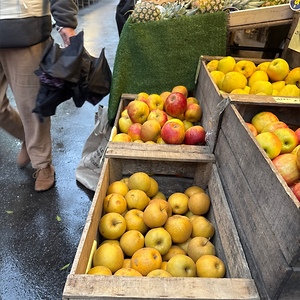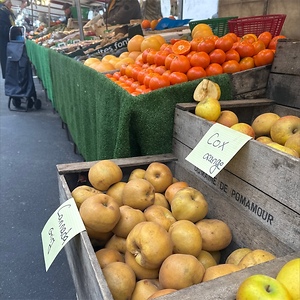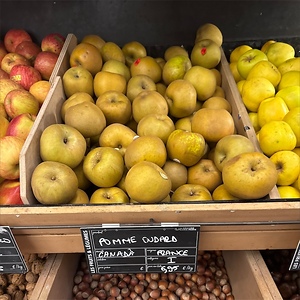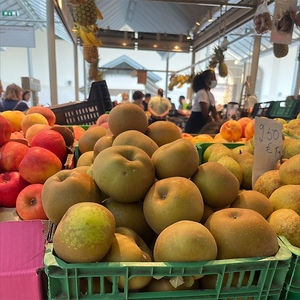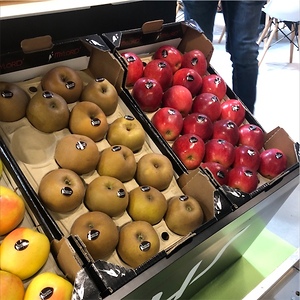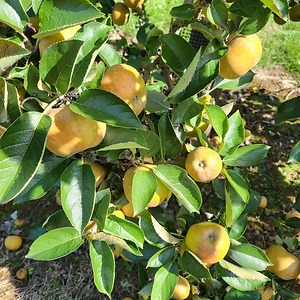

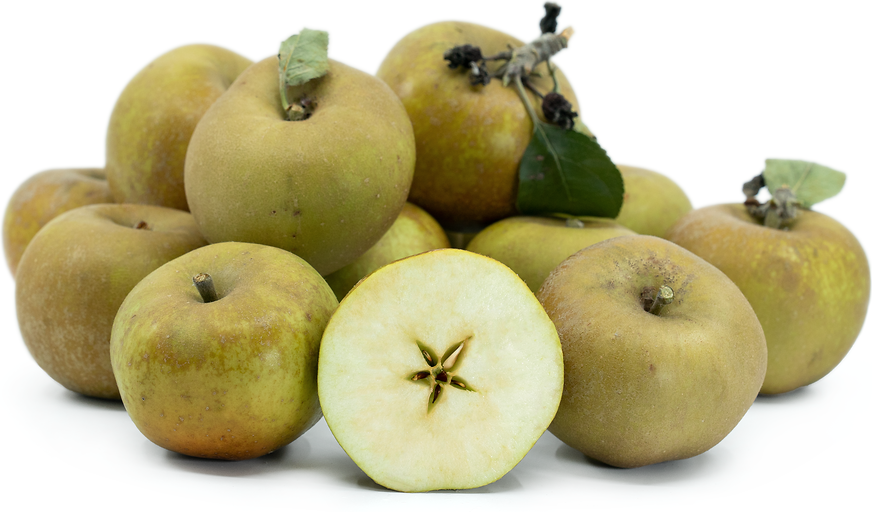
Reinette Grise du Canada Apples
Estimated Inventory, lb : 0
Description/Taste
Reinette Grise du Canada apples are a medium to large varietal, averaging 7 to 9 centimeters in diameter, and have a round to ovate shape with a slightly lopsided, ribbed appearance and a flattened base. The apple’s skin has a green hue, but the surface is almost completely covered in a golden-brown russet, giving the skin a sandy, rough texture. The skin is also sometimes blushed with patches of orange, depending on sun exposure, and a few faint lenticels are scattered across the surface. Underneath the surface, the white to pale yellow flesh is tinged with green and is coarse, firm, and crisp. As the fruits are kept in extended storage, the flesh softens and develops a crumbly, semi-dry consistency. When freshly harvested, Reinette Grise du Canada apples have a sweet-tart, sharp, green apple flavor, mellowing in storage to a sweeter, subtly tart taste.
Seasons/Availability
Reinette Grise du Canada apples are available in the late fall through winter.
Current Facts
Reinette Grise du Canada apples, botanically classified as Malus domestica, are a late-season variety belonging to the Rosaceae family. The heirloom apples were believed to be a sport of the reinette du Canada apple and were discovered in France sometime in the early 19th century. Reinette Grise du Canada apples exhibited a more uniform russet on their skin and became a favored commercial variety in France. The golden russet apples are also versatile, changing slightly in flavor and texture with extended storage. When Reinette Grise du Canada apples are freshly harvested from the orchards, the apples are one of the most used russet varieties for desserts, baked goods, and purees. As they are left to mature in storage, they develop a sweeter taste suitable for fresh preparations. It is unknown how the variety acquired its name, but Reinette Grise du Canada apples are widely found in French markets under the simplified name of Pommes du Canada or just Canada.
Nutritional Value
Reinette Grise du Canada apples are a good source of potassium to balance fluid levels within the body, fiber to regulate the digestive tract, and vitamin C to strengthen the immune system while reducing inflammation. The apples also contain other vitamins, including vitamin A to maintain healthy organ functioning, vitamin E to protect the cells against free radical damage, and vitamin K to assist in faster wound healing. Beyond vitamins, the apples contain minerals such as magnesium to control nerve functioning and other nutrients such as boron, iron, zinc, calcium, phosphorus, and copper.
Applications
Reinette Grise du Canada apples are utilized for fresh and cooked preparations at different points during their storage life. When first harvested, the apples have a sweet-tart, spice-filled flavor and hold their shape well when heated, traditionally used in cooked preparations. Reinette Grise du Canada apples can be baked into pies, cakes, tarts, crumbles, crisps, and strudels, simmered into sauces, or cooked into a textured puree. After about 1 to 2 months in storage, Reinette Grise du Canada apples mellow in flavor, developing a sweeter taste, and the flesh becomes slightly drier, easily crumbled. Stored Reinette Grise du Canada apples can be consumed straight, out of hand, or they can be sliced and tossed into salads, mixed into fruit bowls, or served on charcuterie plates with cheeses. The apples can also be used as a fresh topping over pancakes, parfaits, and oatmeal, sliced and dipped into nut butter, layered into sandwiches, or dried for extended use. Reinette Grise du Canada apples pair well with cheeses such as camembert, cheddar, brie, and goat, nuts including pecans, almonds, pistachios, and walnuts, dried fruits such as figs, cranberries, raisins, and dates, and spices including cinnamon, ginger, cloves, allspice, and nutmeg. Whole, unwashed Reinette Grise du Canada apples will last 4 to 6 months when kept in professional cold storage.
Ethnic/Cultural Info
Reinette Grise du Canada apples are one of the most famous heritage apple varieties incorporated into French desserts, especially in tarts. When cooked, the apples hold their shape and contribute sweet and sharp flavors, creating a complex, caramelized dessert. Tarts are traditionally comprised of a thin layer of pastry covered in a sweet or savory filling, and the dessert is baked to develop a warm dish. The pastry can be traced back to medieval Europe and was a favored dish among the upper-class dinner parties, specifically fruit tarts that showcased artfully arranged slices of fruit on the surface. One type of tart unique to France that Reinette Grise du Canada apples are frequently used in is Tarte Tatin. Legend has it that this upside-down tart was created at l’Hotel Tatin in the Loire Valley of France in 1888, run by the Tatin sisters Stephanie and Carolina. Stephanie, the older sister, ran the kitchen at the hotel and was known for her tarts. One day when Stephanie was busy cooking in the kitchen, she added butter, spices, and apples into a pan but forgot to line the bottom with pastry. Stephanie did not have time to remake the tart, so she inverted the dessert and placed the pastry on top of the sliced apples. Once the dish was cooked, she flipped the dish onto a plate, revealing an attractive, caramelized surface showcasing the sliced apples. Stephanie also served the tart warm, causing the cream spooned over the dessert to melt into a warm, flaky, and decadent dish. The inverted tart was a success, and the dessert was known as Tarte des demoiselles Tatin after the two unmarried sisters. Historians also mention that there were rumors that the chef at Maxim’s Restaurant of Paris sent a spy to the sister’s hotel to steal the recipe. While there is no proof of this escapade, the esteemed restaurant caused the tart to become famous, and the Tart Tatin has been featured on the restaurant’s menu for decades.
Geography/History
Reinette Grise du Canada apples were developed from reinette du Canada apples, an heirloom variety believed to be native to Normandy, France. Much of the apple’s history is unknown, but reinette du Canada apples were first recorded in the 18th century and were widely grown as a commercial cultivar in the early 19th century. Pomologists hypothesize that Reinette Grise du Canada apples are a natural sport of the reinette du Canada apple, appearing sometime as a mutation in an orchard in the early 19th century. The apples were grown commercially and in private orchards throughout Europe throughout the 19th and 20th centuries and were eventually planted in the New World in the mid-19th century. In 1901, Reinette Grise du Canada apples received an Award of Merit by the Royal Horticultural Society in England for its popularity as a flavorful russet apple. Today Reinette Grise du Canada apples are sold through local markets, farm stands, and distributors in Europe and North America. In some regions, identification can be somewhat tricky as select growers sell Reinette Grise du Canada and reinette du Canada as the same apple and use the names interchangeably on market signs.



